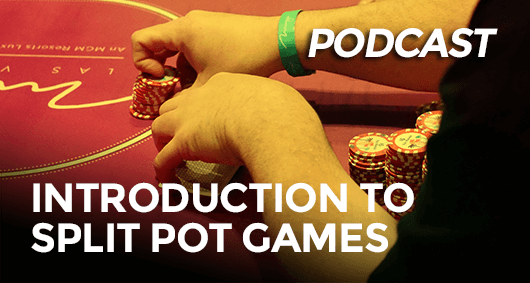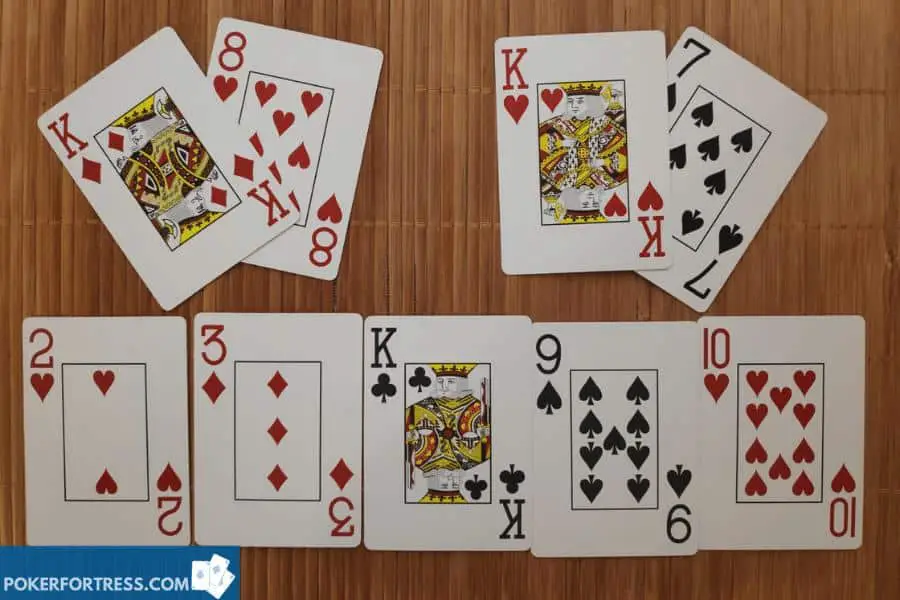Split Pot Poker Flush
Sometimes, at the conclusion of the hand, more than one player is entitled to a part of the pot. A split pot is a pot that is split among 2 or more players. Depending upon the game that you are playing, this can be a relatively rare occurrence, or a commonplace event.
If instead of the 2♠ on the board that card was the T♦, both players would have the same flush (playing the board) and the pot would be split. Example 3 - Two Players Have Two Pairs When two players have two pairs, it can sometimes be confusing for people to know which poker hand wins. A split pot poker variant is where the two halves of the pot are awarded based on different hand rankings criteria. For example, in Omaha Hi/Lo split half of the pot is awarded to the best high hand while half of the pot is awarded to the best low hand. In poker, if no winner can be determined with a tiebreaker, then the hand is declared a tie and the tied players split the pot. The most frequent time there is a tie in poker is where the board is paired twice and two or more players each have the same high card. Examples of tied hands: One player has AK and the other has AQ and the board is J2255. To split a pot is simply to divide the chips among the winners. This process primarily occurs on the river. The chips in the pots are allocated to the active winning players still in the hand. In, poker for every winner there has to be a loser. I thought that was right but as I mentioned I am playing on a free poker site called 247 poker and they maintain its a split pot presumably they are saying because the A is a community card it's a shared A high flush.
In a hi/lo game, like Omaha Eight or Better (O8), by rule half of the pot is awarded to the high hand and half of the pot is awarded to the low hand, so long as a player makes a qualifying low hand. This makes split pots a very common occurrence in hi/lo games. Split pots occur so frequently in these games that they are often referred to as “split pot games.”

In these games, splitting the pot has strategic implications. Players may play for the high side of the pot, the low side, or both. Here, it is best to have a multiway action hand which has the potential to win both sides of the pot. This is why players tend to focus on hands which contain A-2, along with a valuable combination of high cards. The most powerful hand before the flop in O8 is A-A-2-3, double suited. Hands with high only values or low oriented hands can also be valuable, depending upon the flop.
It is important to realize that it is much easier to make a low hand in these games than it is to make a high hand. In fact, lows occur with such frequency in O8, that it is relatively common for more than one player to make a nut low during the same hand. When this happens, multiple players must split the low side of the pot evenly. If there are one high hand and two low hands, the high hand will receive 50% of the pot, and the two low hands will each receive 25%. For the holders of the low hands, this is called “getting quartered.” If there are only three of you in the pot in this situation (one high and two lows), the low will be putting in 33% of the money, but you will only be receiving back 25% of the money at the conclusion of the hand. As you can see, it is easy to lose money getting quartered with the nut low. You will need substantial action from the rest of the field, if you are to make any profit at all on a hand which you are getting quartered on. Many newbies do not understand the math on this and insist upon raising and reraising anytime that they make the nut low. This is a bad idea and it will annoy the experienced players at the table to no end. To be effective, you must learn not to overvalue the low. Since the low must qualify in order to be eligible for any part of the pot, and the risk of getting quartered is substantial, it is often better to make the high hand than the low. Sometimes three or more people will all make the same low on a hand, but a split pot on the high side occurs with much less frequency. When a multi-way low split occurs, it can result in each low hand getting a sixth, or less, or the pot. This is why the very best hands have good potential to win both sides of the pot.

 Split pots occur more infrequently in high only games like Texas Hold’em. In these games, the low is worthless and is not entitled to any of the pot. In order for a split pot to occur in a Hold’em game, two or more players must make identical high hands. Players may make identical hands using two, one, or none of their hole cards. If no hole cards are played, players will be playing the board, and all active players will be entitled to an equal share of the pot. More frequently, players will split a pot because they complete their hand with the same single hole card. This happens most often when a single card is needed to complete a straight, or when the board is such that only a one card kicker plays. It is not possible for a chop on the high side to occur when the winning player completes a flush using either one or two hole cards. Players will also split the pot anytime there are two or more winning hands with exactly the same two playing hole cards.
Split pots occur more infrequently in high only games like Texas Hold’em. In these games, the low is worthless and is not entitled to any of the pot. In order for a split pot to occur in a Hold’em game, two or more players must make identical high hands. Players may make identical hands using two, one, or none of their hole cards. If no hole cards are played, players will be playing the board, and all active players will be entitled to an equal share of the pot. More frequently, players will split a pot because they complete their hand with the same single hole card. This happens most often when a single card is needed to complete a straight, or when the board is such that only a one card kicker plays. It is not possible for a chop on the high side to occur when the winning player completes a flush using either one or two hole cards. Players will also split the pot anytime there are two or more winning hands with exactly the same two playing hole cards.
Usage: Stud Split, Splitting the Pot
Split Pot Poker Flush Kit
Previous Poker Term: Small Blind
